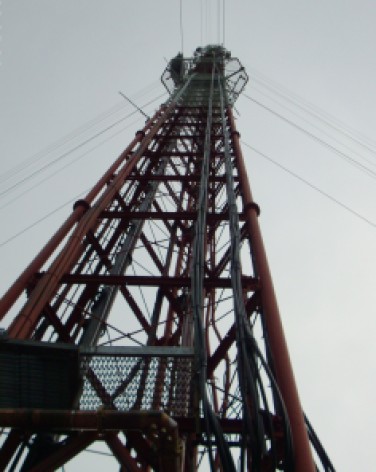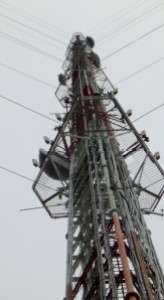Podcast: Play in new window | Download | Embed
Subscribe: Apple Podcasts | RSS
Hello all,
Young field workers, pay attention! This could save your life! He is sharing this to help you know not only how to treat this horrible disease but how to prevent it.
Bruce Holsted, a great guy! He opened up to me about how RMSF (Rocky Mounted Spotted Fever) stole 3 years of his life, and he has 2 more years to fully recover. It appears it is expected to take him 5 years to fully recover. All this form the bite of a tick. Luckily, the doctor he saw knew what he had. Unfortunately he waited 6 months to see a doctor.
Let me tell you about some of Bruce’s background. This is a company owner and a tower guy that has 4 full-time crews, hiring subs as needed. This is a guy that built his business over the past 24 years. This is a Hospice volunteer that gives his time to assist more than 25 people a year. This is a guy that has written 2 books, that I know of, for his descendants only to sell quite a few of them on Amazon. I spoke to him and he is a genuinely a good man. He is a Hospice volunteer, something I hold dear to my heart since losing my father a few years back. Bruce is a good man.
So how did a tiny tick almost ruin his life? One tick bite was enough to give him RMSF and cause him so many issues. It started with muscle cramps, mental confusion and more. He had arthritis and so many infections that affected his teeth and his prostrate. This disease almost ruined him, caused him to make bad decisions, and miss important meetings as well as some of his life. It cost him thousands of dollars and he almost lost his business.
Luckily he has a good wife and support of friends that helped him through this horrible ordeal. He also had a doctor that knew what he had and what to look for and how to treat it. He is doing well these days but he still has 2 more years of recovery. He has to keep a close watch on his health because he never knows how it will affect him next.
Prevention, prevention, prevention!So listen to the podcast for his story, not my words. He mentioned that we make sure you know that to kill ticks before they bite you by covering your clothes with Permethrin. This is so important because the best treatment for any tick bite born disease is prevention! What is it? Go to http://en.wikipedia.org/wiki/Permethrin and you will see that it is an insecticide that Bruce uses to kill ticks. You put it on your boots and jeans.
If you have RMSF there is support, go to the Facebook page Survivors of Rocky Mountain Spotted Fever and Lyme Disease and you will see that there are others out there that went through what you are going through. Support for people going through this is very important! I want you to know that you are not alone.
Let me know what you think on Facebook.
More information on Permethrin;
http://www.epa.gov/oppsrrd1/REDs/factsheets/permethrin_fs.htm
http://npic.orst.edu/factsheets/Permtech.pdf
It comes in a spray bottle for your clothing sold here;
http://www.rei.com/product/768970/sawyer-permethrin-pump-spray-24-oz
http://www.amazon.com/Sawyer-Products-Permethrin-Clothing-Repellent/dp/B007VCRX2S
To learn more about Bruce, go to http://www.bruceholsted.com/ and see his books, Sacred Spaces and Steps to a Conversation of Mind to learn more. Make sure you go to the photos section and look over all the pictures, there are several tower and engineer pictures in there. It is worth a look. He also has a Hospice section for those of you who are curious about it. God bless this man!
From my previous blog about ticks;
If you go to this site http://www.medicinenet.com/rocky_mountain_spotted_fever_pictures_slideshow/article.htm you will see a good explanation of the ticks and the disease. They also give hints on how to remove the tick safely and disinfect your wound after the tick is removed. Then save it in case you get sick. Put it in a zip lock bag or pill bottle and freeze it. This will give you something to take to the doctor and explain that you have a tick bite. That may help them diagnose the problem.
Some links that may help explain this tick bite disease.
http://en.wikipedia.org/wiki/Rocky_Mountain_spotted_fever
http://kidshealth.org/parent/infections/skin/rocky.html
http://www.webmd.com/skin-problems-and-treatments/rocky-mountain-spotted-fever
http://www.wbiw.com/local/archive/2014/06/officials-warning-about-ticks.php
http://blog.extension.uconn.edu/tag/deer-ticks/
On this one you need to scroll down to the article. http://www.onhealth.com/rocky_mountain_spotted_fever/article.htm#rocky_mountain_spotted_fever_rmsf_facts
NATE has a Planning Advisory Notice (PAN) for safety, http://natehome.com/wp-content/uploads/2014/06/PAN-NOV-DEC-2013.pdf and the main page for all NATE PANs is here, http://natehome.com/safety-education/planning-advisory-notice-pan/ if you’re interested. They have PANs for ANSI/TIA 1019-!-2012, Antenna Installations, Mounts and Inspections, FAA Aviation Obstruction Lighting, and Anchor Bolts.











